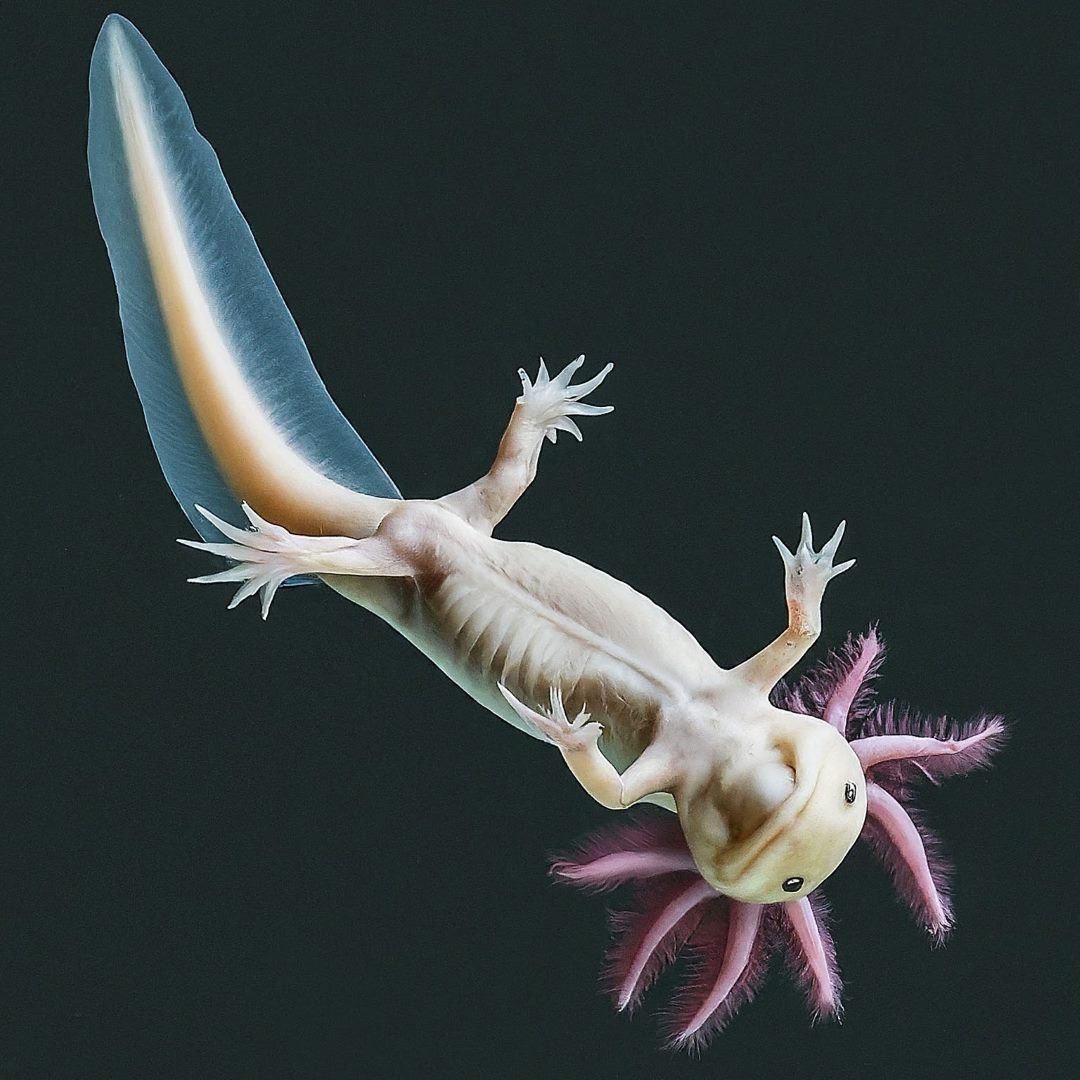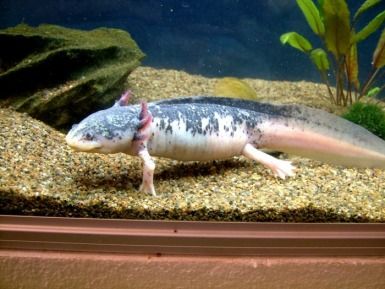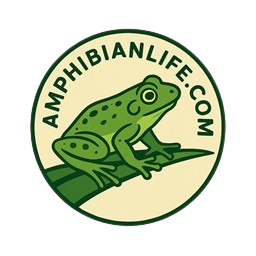
Understanding why axolotls might be lying or swimming upside down is essential for maintaining their health and ensuring they thrive in their aquatic environment. This detailed guide explores the various causes of such behavior, from swim bladder issues to environmental stressors, and provides solutions to address and prevent these problems.
An axolotl swimming or lying upside down can be due to several factors, including buoyancy problems, swim bladder disorders, poor water quality, stress, temperature fluctuations, Improper feeding habits, constipation, infections, genetic disorders, and physical injuries can also contribute.
Addressing water quality, diet, temperature, and handling, while monitoring for signs of illness or injury, is crucial for maintaining your axolotl’s health and well-being.

1. Swim Bladder Issues
Swim bladder problems are a common cause of upside-down floating in axolotls. The swim bladder is an internal organ that helps control buoyancy, allowing the axolotl to maintain its position in the water column. Issues with the swim bladder can lead to buoyancy problems, causing the axolotl to float upside down or tilt to one side.
Several factors can affect the swim bladder:
- Constipation: Overfeeding or consuming inappropriate food can lead to constipation, which can in turn affect the swim bladder’s function. When the digestive tract is overloaded, it can press on the swim bladder, causing buoyancy issues.
- Gas Build-Up: Eating air while feeding can also lead to gas build-up in the swim bladder, disrupting buoyancy. Switching to sinking pellets and ensuring that food is appropriately sized can help mitigate this issue.
Solutions: Adjust the diet to include sinking pellets and provide a balanced mix of live or frozen foods such as bloodworms and brine shrimp. Ensure that the axolotl is not overfed and consider fasting for a day or two if constipation is suspected.
2. Temperature Fluctuations
Temperature fluctuations can significantly impact an axolotl’s buoyancy and overall health. Axolotls are sensitive to changes in their environment, and extreme temperatures can cause stress and disrupt their natural buoyancy mechanisms.
Cold Shock: Axolotls thrive in a stable water temperature range of 60-64°F (15-18°C). Sudden drops in temperature can shock their system, leading to buoyancy problems and other health issues. Cold water can also slow down their metabolism and make them less active.
Heat Stress: Conversely, excessively high temperatures can also stress axolotls. If the water temperature rises above their comfort range, it can lead to discomfort and health issues. High temperatures can speed up their metabolism and increase their stress levels, affecting their buoyancy and overall well-being.
Solutions: Maintain a stable water temperature within the recommended range. Use a reliable aquarium heater to regulate temperature and avoid placing the tank in drafty areas or direct sunlight. Monitor temperature changes closely and make adjustments gradually to prevent sudden shocks.
3. Water Quality Issues
Water quality is crucial for the health of axolotls. Poor water conditions can lead to various health issues, including buoyancy problems. Key water quality parameters include ammonia, nitrites, nitrates, and pH levels.
Water Quality Parameters for Axolotls:
| Parameter | Acceptable Range |
|---|---|
| Temperature | 16-18°C (60-64°F) |
| pH | 6.5-8.0 |
| Ammonia | 0 ppm |
| Nitrite | 0 ppm |
| Nitrate | Below 20 ppm |
| Chlorine | 0 ppm |
Ammonia Levels: High levels of ammonia in the tank can stress axolotls and lead to buoyancy problems. Ammonia is a byproduct of decomposing organic matter, such as uneaten food and waste. Elevated ammonia levels can damage the gills and internal organs of axolotls, affecting their buoyancy and overall health.
Solutions: Regularly test the water for ammonia, nitrites, and nitrates. Perform partial water changes to keep these levels in check and use a filter suitable for axolotls. Ensure the tank is properly cycled to establish beneficial bacteria that help break down waste. Remove uneaten food promptly to prevent water quality issues.
4. Slow and Gradual Changes
Gradual Changes in the tank environment are crucial for maintaining the health of axolotls. Rapid changes in temperature, water quality, or tank conditions can cause stress and disrupt buoyancy.
Solutions: Implement changes slowly and monitor the axolotl’s response. For example, when adjusting the water temperature or making changes to the tank setup, do so gradually to give the axolotl time to acclimate. Avoid making abrupt changes that could shock their system.
credits: caudata.org
5. Stress and Environment
Stress is a significant factor that can cause axolotls to float upside down or exhibit other abnormal behaviors. Panic can result from various factors, including changes in the tank environment, overcrowding, or aggressive tankmates.
Tank Environment: Ensure the tank is appropriately sized and provides adequate hiding spots and cover. Overcrowding or introducing aggressive tankmates can lead to stress and buoyancy problems.
Handling and Interactions: Excessive handling or disturbances can also stress axolotls. They are sensitive creatures that prefer minimal interaction. Handling should be kept to a minimum, and any interactions should be gentle and brief.
Solutions: Create a stable and calm environment for the axolotl. Ensure the tank size is suitable and provides ample hiding spots. Minimize handling and disturbances to reduce stress. Avoid introducing aggressive or incompatible tankmates.
6. Infections or Illness
Is My Axolotl Sick? Signs to look for
Infections or sickness can affect an axolotl’s buoyancy and overall health. Common infections include bacterial infections and parasitic infestations.
Bacterial Infections: Conditions such as red leg disease or fungal infections can impact buoyancy. Symptoms may include redness, lesions, or unusual growths. Bacterial infections can cause general health decline and affect the swim bladder.
Parasitic Infestations: Parasites like anchor worms or flukes can also lead to buoyancy issues. Infestations can cause irritation, abnormal behavior, and changes in buoyancy.
Solutions: If you suspect an infection or parasitic infestation, quarantine the affected axolotl and seek veterinary assistance promptly. A veterinarian experienced in amphibian care can provide an accurate diagnosis and recommend appropriate treatments.
7. Gas or Bloating
Gas or bloating in axolotls can lead to buoyancy issues, causing them to float upside down. This can occur due to several factors, including constipation, overfeeding, or impaction.
Constipation: Constipation can result from overfeeding or an inappropriate diet. When the digestive system is overloaded, it can press on the swim bladder, causing buoyancy problems.
Overfeeding: Feeding too much food or giving inappropriate types of food can lead to digestive issues and bloating. Overfeeding can also cause gas build-up in the digestive tract, affecting buoyancy.
Improper Diet: A diet lacking in variety or consisting of low-quality food can contribute to digestive problems and bloating. Feeding feeder fish or unsuitable foods can cause further issues.
Impaction: Ingesting substrate or gravel can cause impaction, leading to bloating and buoyancy problems. Impaction can occur if axolotls consume small gravel or other objects that obstruct their digestive tract.
Solutions: Adjust the diet to include appropriate portions and high-quality food. Avoid overfeeding and provide a balanced diet with a variety of live or frozen foods. Ensure the tank has a suitable substrate to prevent ingestion. If impaction is suspected, monitor the axolotl for signs like reduced appetite or lethargy and seek veterinary assistance if needed.
8. Physical Injury
Physical injuries can cause axolotls to swim upside down. Injuries can result from accidents, rough handling, or sharp objects in the tank.
- Trauma: Accidental falls, sharp tank decorations, or rough interactions can cause internal injuries that affect buoyancy. Signs of physical injury may include open wounds, swelling, or abnormal behavior.
- Symptoms: Injured axolotls may exhibit changes in swimming patterns, including floating upside down.
Solutions: Inspect the axolotl for any signs of injury and provide appropriate care. If you notice wounds, swelling, or other signs of trauma, seek veterinary care immediately. Ensure that the tank environment is safe and free from sharp objects to prevent future injuries.
9. Genetic Factors
Genetic factors can also play a role in an axolotl’s tendency to swim upside down. Some axolotls may have genetic predispositions that affect their buoyancy.
- Inherited Traits: Certain genetic traits may make some axolotls more prone to buoyancy issues. These traits may not always be preventable or treatable.
Solutions: If your axolotl continues to swim upside down despite optimal care, it may be genetically predisposed to this behavior. Monitor the axolotl closely for any signs of distress and ensure it can reach the surface to breathe comfortably. Providing a stable and stress-free environment can help improve its overall well-being.
What to Do If Your Axolotl is Floating
- Check water quality: Test for ammonia, nitrite, nitrate, and chlorine levels. Perform a partial water change if necessary.
- Adjust feeding: Reduce the amount of food you’re feeding your axolotl and consider fasting for a day or two.
- Observe for other symptoms: If you notice other signs of illness, consult a veterinarian specializing in amphibians.
Conclusion
Maintaining the health and well-being of axolotls involves understanding and addressing the various factors that can cause buoyancy issues. From swim bladder problems and temperature fluctuations to water quality and stress, each factor plays a role in the overall health of these fascinating amphibians. Regular monitoring of water conditions, maintaining a stable environment, and providing a balanced diet are essential steps in preventing and addressing buoyancy problems.
If your axolotl exhibits persistent buoyancy issues despite your efforts, seeking advice from a veterinarian with expertise in amphibian care is crucial. Prompt attention to their needs and addressing any abnormalities or health concerns will help ensure the long-term health and happiness of your axolotl.
